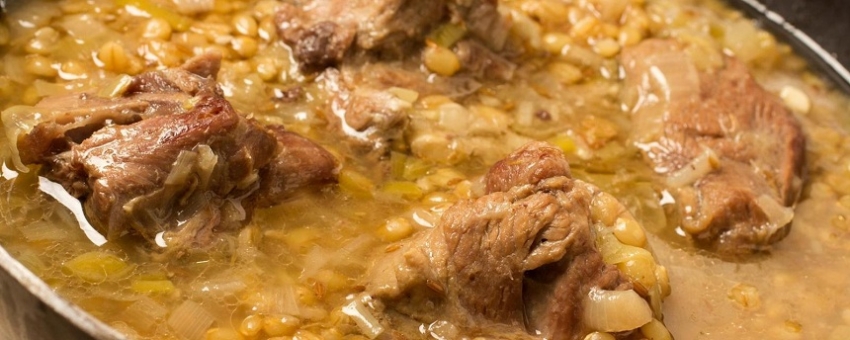A team of international scholars versed in culinary history, food chemistry and cuneiform studies has been recreating dishes from the world’s oldest-known recipes.
y Ashley Winchester
The instructions for lamb stew read more like a list of ingredients than a bona fide recipe: “Meat is used. You prepare water. You add fine-grained salt, dried barley cakes, onion, Persian shallot, and milk. You crush and add leek and garlic.” But it’s impossible to ask the chef to reveal the missing pieces: This recipe’s writer has been dead for some 4,000 years.
Instead, a team of international scholars versed in culinary history, food chemistry and cuneiform (the Babylonian system of writing first developed by the ancient Sumerians of Mesopotamia) have been working to recreate this dish and three others from the world’s oldest-known recipes. It’s a sort of culinary archaeology that uses tablets from Yale University’s Babylonian Collection to gain a deeper understanding of that culture through the lens of taste.
You may also be interested in:
• The Iraq city that opens its doors
• Israel’s millennia-old ‘biblical diet’
• The birthplace of ice cream
“It’s like trying to reconstruct a song; a single note can make all the difference,” said Gojko Barjamovic, pointing to the paperback-sized tablets under glass at the Yale Peabody Museum of Natural History. Barjamovic, a Harvard University Assyriology expert, retranslated the tablets and put together the interdisciplinary team tasked with bringing the recipes back to life.
A team of scholars are recreating ancient recipes from cuneiform tablets (Credit: Credit: Yale Babylonian Collection)
A team of scholars are recreating ancient recipes from cuneiform tablets (Credit: Yale Babylonian Collection)
Three of Yale’s tablets date to around 1730BC, and a fourth is from about 1,000 years later. All of the tablets are from the Mesopotamian region, which includes Babylon and Assyria – what is today the regions of Iraq south of Baghdad and north of Baghdad, including parts of Syria and Turkey. Of the older three tablets, the most intact is more of a listing of ingredients that amounts to 25 recipes of stews and broths; the other two, containing an additional 10-plus recipes, go further in depth with cooking instructions and presentation suggestions, but those are broken and therefore not as legible.
The challenge was to peel back the layers of history while also maintaining authenticity amid the limitations of modern ingredients.
“They’re not very informative recipes – maybe four lines long – so you are making a lot of assumptions,” said Pia Sorensen, a Harvard University food chemist who worked, along with Harvard Science and Cooking Fellow Patricia Jurado Gonzalez, on perfecting the proportions of ingredients using a scientific approach of hypothesis, controls and variables.
The tablets are from the Mesopotamian region, what is today parts of Iraq, Syria and Turkey (Credit: Credit: NurPhoto/Getty Images)
The tablets are from the Mesopotamian region, what is today parts of Iraq, Syria and Turkey (Credit: NurPhoto/Getty Images)
“All of the food materials today and 4,000 years ago are the same: a piece of meat is basically a piece of meat. From a physics point of view, the process is the same. There is a science there that is the same today as it was 4,000 years ago,” Jurado Gonzalez said.
The food scientists used what they know about human tastes, preparation essentials that don’t drastically change over time, and what they hypothesised might be correct ingredient proportions to come up with their best guess as to the closest approximation of an authentic recipe.
“This idea that we can be guided by what works – if it’s too liquidy, it’s going to be a soup. By looking at the material parameters, we can zoom in on what it is” – in most cases, a stew, Sorensen said.
What the researchers revealed shows, in part, the evolution of a lamb stew that is still prevalent in Iraq, hand-in-hand with a glimpse back in time at the “haute cuisine of Mesopotamia” that highlights the sophistication of 4,000-year-old chefs, said Agnete Lassen, associate curator of the Yale Babylonian Collection.
There is a notion of ‘cuisine’ in these 4,000-year-old texts
The four dishes culled from the list-style tablet also each have unique uses. Pashrutum, for example, is a soup one might serve someone suffering from a cold, Lassen said, though the meaning of this bland broth accented by leek, coriander and onion flavours translates as “unwinding”. Elamite broth (“mu elamutum”), on the other hand, is among two foreign (or “Zukanda”) dishes listed in the tablets, Barjamovic said.
He equates this to the present-day ubiquity of “foreign” dishes like lasagne or skyr or hummus that have been taken out of their homeland and adapted to new palates, and are indicative of contact between neighbouring cultures.
“There is a notion of ‘cuisine’ in these 4,000-year-old texts. There is food which is ‘ours’ and food that is ‘foreign,’” Barjamovic said. “Foreign is not bad – only different, and sometimes apparently worth cooking, since they give us the recipe.”
Tuh'u recipe
Ingredients:
1 lb leg of mutton, diced
½ c rendered sheep fat
1 small onion, chopped
½ tsp salt
1 lb beetroot, peeled and diced
1 c rocket, chopped
½ c fresh coriander, chopped
1 c Persian shallot, chopped
1 tsp cumin seeds
1 c beer (a mix of sour beer & German Weißbier)
½ c water
½ c leek, chopped
2 garlic cloves, peeled and crushed
For the garnish:
½ c fresh coriander, finely chopped
½ c kurrat (or spring leek), finely chopped
2 tsp coriander seeds, coarsely crushed
Instructions: Heat sheep fat in a pot wide enough for the diced lamb to spread in one layer. Add lamb and sear on high heat until all moisture evaporates. Fold in the onion and keep cooking until it is almost transparent. Fold in salt, beetroot, rocket, fresh coriander, Persian shallot and cumin. Keep on folding until the moisture evaporates. Pour in beer, and then add water. Give the mixture a light stir and then bring to a boil. Reduce heat and add leek and garlic. Allow to simmer for about an hour until the sauce thickens.
Pound kurrat and remaining fresh coriander into a paste using a mortar and pestle. Ladle the stew into bowls and sprinkle with coriander seeds and kurrat and fresh coriander paste. The dish can be served with steamed bulgur, boiled chickpeas and bread.
Source: Food in Ancient Mesopotamia, Cooking the Yale Babylonian Culinary Recipes, with permission from co-author and translator Gojko Barjamovic.
Though its blood-based broth would be completely forbidden by today’s Islamic and Jewish tradition, the Elamite broth dish originated in what is now Iran, and also uses dill, an ingredient not otherwise mentioned among the tablets, Barjamovic and Lassen said. This is a distinction still apparent today: Iraqi cuisine rarely uses dill, whereas it is common in Iranian cuisine, which may indicate the pattern was established millennia ago, Barjamovic said. Nasrallah notes the “foreign” designation is indicative of trade between the two cultures, and an appreciation for tastes not commonly associated with local cuisine. The Babylonians might have associated the taste of dill with Elamite cuisine in the same way that we associate fresh coriander with Hispanic foods, Nasrallah said.
There’s also an element of showmanship and skill that carries over among chefs through the millennia, the researchers noted. Just as today’s molecular gastronomers might delight in plating a dish to play with diners’ expectations, so, too, did Mesopotamian chefs in preparing elaborate feasts fit for high society. Think: the Ferran Adrià flourish of ancient Assyria.
One dish resembles a chicken pot pie, with layers of dough and chunks of bird smothered by a sort of Babylonian béchamel sauce, said culinary historian and Iraqi cuisine expert Nawal Nasrallah, whose research on medieval Arabic foods helped tie the ancient tablets to later cooking techniques from the same region. Its presentation also contains an element of surprise, she said. The bird dish was served covered by a crusty lid, which diners then opened to reveal the meat inside. It’s a food-within-a-food technique Nasrallah sees repeated in the 10th-Century Baghdadi cookbook Kitab al-Tabikh (“Cookery Book”), describing local medieval traditions, and again in modern Iraqi cuisine.
Nawal Nasrallah: "In the Arab world and particularly in Iraq, we pride ourselves in stuffed dishes like dolma" (Credit: Credit: Mahmoud Masad/Alamy)
Nawal Nasrallah: "In the Arab world and particularly in Iraq, we pride ourselves in stuffed dishes like dolma" (Credit: Mahmoud Masad/Alamy)
“Today, in the Arab world and particularly in Iraq, we pride ourselves in stuffed dishes like dolma. We kind of inherited this tendency of showmanship of cooks,” Nasrallah said. “In this way, I was really fascinated by the continuity of the cuisine and what has survived.”
This sophistication of preparation in the Babylonian food includes the use of colourful ingredients like saffron or coriander, parsley and chard to appeal to the eye and the palate, as well as employing a fish sauce sourced from the abundance of the Tigris and Euphrates rivers to add an umami element to the dishes, Nasrallah said. Today’s stews from the region are usually red, from tomatoes (which arrived centuries later), but the flavour elements of cumin, coriander, mint, garlic and onions are still recognisable. Rendered sheep’s tail fat (in Arabic, alya) for instance, was considered a delicacy and an “indispensable ingredient in Iraq, until around the 1960s", Nasrallah said.
“I see the same tendency from ancient times to today; we don’t just add salt and black pepper, we add a combination of spices to enhance the aroma, to enhance the flavour, and we don’t just add it all at once, we add it in stages and we allow the stew to simmer,” Nasrallah said.
The scientists perfected the proportions of ingredients using a scientific approach of hypothesis, controls and variables (Credit: Credit: Yale Babylonian Collection)
The scientists perfected the proportions of ingredients using a scientific approach of hypothesis, controls and variables (Credit: Yale Babylonian Collection)
The lamb stew, me-e puhadi, is meant to be eaten with barley cakes crumbled into the liquid, as one might do today with bread to sop up a soup. The scholars’ resulting version of the dish offers a hearty taste and texture teased out from months of trial and error and by using the scientific method of variables and controls to unravel the recipe’s mysteries. They realised, for example, when the inclusion of soapwort, a perennial plant sometimes used as a mild soap, was a mistranslation: adding this ingredient in any measure made the resulting dish bitter, frothy and unpalatable. Similarly, levels of seasonings have a threshold: there is an amount of salt in any dish, whether 4,000 years ago or today, that will render it inedible, they said.
Modern eaters might recognise elements of several cultures’ comfort foods in these Mesopotamian meals. Tuh’u, for instance, uses red beetroots and shares similarities with both the borscht prevalent in Ashkenazi cuisine, as well as a stew prevalent among Iraqi Jews called Kofta Shawandar Hamudh (meatballs with sweet and sour beetroots), according to Nasrallah. The lamb stew, likewise, calls for meat sautéed in sheep-tail’s fat. A close cousin to the stew might be Iraqi pacha, a dish Nasrallah remembers her mother cooking that uses all the parts of the sheep, preparing the carcass in similar ways as are described in the tablets.
The instructions for lamb stew read more like a list of ingredients (Credit: Credit: Yale Babylonian Collection)
The instructions for lamb stew read more like a list of ingredients (Credit: Yale Babylonian Collection)
“I was really surprised to find that what is a staple in Iraq today, which is a stew, is also a staple from ancient times, because in Iraq today, that is our daily meal: stew and rice with a bread,” Nasrallah said. “It is really fascinating to see how such a simple dish, with all its infinite variety, has survived from ancient times to present, and in those Babylonian recipes, I see not even the beginnings; they already had reached sophisticated levels in cooking those dishes. So who knows how much earlier they began?”
Jews adapted Palestinian recipes for dishes like falafel (Credit: Credit: PhotoStock-Israel/Getty Images)
Middle East Israel
Food & Drink
Israel’s millennia-old ‘biblical diet’
A new generation of academics and chefs are cooking with ancient grains and herbs, using ‘original recipes’, to help work through Israel’s long-unresolved legacy of trauma.
Share on Facebook
Share on Twitter
Share on Reddit
Share on StumbleUpon
Share on Google+
Share by Email
By Shira Rubin
9 May 2018
Between Jerusalem and Tel Aviv lies a man-made Garden of Eden, dotted with imported Lebanese cedar trees, reconstructed olive and wine presses and reproduced ancient gardens of wild sage and edible flowers. But the nature reserve, known as Neot Kedumim, is more than just a recreation of the landscape of biblical times. Since the 1990s, Israel’s foremost food archaeologist Tova Dickstein has been cultivating it as an open-air laboratory to examine the millennia-old ‘biblical diet’ and the ingredients that are making a comeback in Israeli nouvelle cuisine.
“The ancient culture was, for a long time, forgotten in Israel,” said Dickstein, explaining that the ancient Israelites ate a far richer and more diverse diet than the hummus, falafel and vegetable diets of early modern-day Israel. At the time of the Bible, ancient Israel was famed for its wine, honey and pomegranates, along with its olive oil, which was used extensively both raw and for cooking the occasional meat and the more frequent stews of legumes like lentils and barley.
Israel’s Neot Kedumim nature reserve is a recreation of the landscape of biblical times (Credit: Credit: Hanan Isachar/Getty Images)
Israel’s Neot Kedumim nature reserve is a recreation of the landscape of biblical times (Credit: Hanan Isachar/Getty Images)
You may also be interested in:
• The planet’s most extreme cuisine?
• The comeback of a 2,000-year-old sauce
• The unlikely sausage that saved lives
Israeli cuisine is currently having its moment on the international stage, but at home, many chefs and food scholars still struggle to determine what makes Israeli cuisine Israeli, or if it even qualifies as a cuisine. As the country splinters along religious, ethnic and political lines, Israel’s iconic foods, from the humble chickpea to the stuffed grape leaf, have been thrust into the centre of heated international debates. Many Palestinian activists, as reported by Haaretz, accuse Israeli chefs of appropriating Palestinian culture, while others, like Dickstein, point to the many influences of the diverse peoples who once inhabited this land on Israel’s culinary history.
Dickstein, a secular Israeli who is fascinated by the Bible and its sparse but deeply poetic references to food, sees the national cuisine as a way out of the political morass by uniting people through their food ancestries. She, along with a new generation of academics and chefs, are cooking with ancient grains and herbs, using what they believe are original recipes to help work through the nation's long-unresolved legacy of trauma.
At Neot Kedumim, Dickstein guides biblical nature tours that delve into the histories of the many wild vegetables and herbs on display, explaining their descriptions in the Bible, their harvest cycles and their multiple health and healing properties. She also leads an outdoor biblical cooking workshop, in which visitors use biblical-era tools to recreate ancient recipes, using, for example, sap from fig trees to curdle milk into cheese.
Food archaeologist Tova Dickstein has been cultivating the ingredients used in the ‘biblical diet’ (Credit: Credit: Shira Rubin)
Food archaeologist Tova Dickstein has been cultivating the ingredients used in the ‘biblical diet’, some of which are making a comeback (Credit: Shira Rubin)
“When I first started, Israelis didn’t want to talk about [biblical food] because they saw it as a religious thing,” she explained, referring to tensions between Israel’s secular majority and its tiny, ultra-Orthodox minority that wields outsized political power, including in the Israeli restaurant scene. Israel’s Chief Rabbinate has long attempted to block the import of non-kosher foods like shrimp. But Dickstein says that biblical food, deeply connected to the Israeli terroir, may provide a more accessible way for contemporary Israelis to appreciate their complex history in this land.
“Like the poet says, ‘Man is nothing without his native landscape’,” she said, quoting one of Israel’s most celebrated poets, Shaul Tchernichovsky.
In fact, Dickstein, who works with fellow Israeli and Palestinian food researchers to decrypt the histories and evolutions of local foods, like wild chicory or ancient grains such as millet and barley, is carrying the culinary torch of the country’s earliest secular founders: Jews from all over the world, who from 1948 onwards used food to build national identity.
Dickstein works with Israeli and Palestinian food researchers to decrypt the evolution of local foods like ancient grains (Credit: Credit: IAISI/Getty Images)
Dickstein works with fellow Israeli and Palestinian food researchers to decrypt the evolution of local foods like ancient grains (Credit: IAISI/Getty Images)
In the 1940s and 1950s, the first waves of Holocaust survivors and immigrants to Israel found an infrastructure-poor Jewish State, plagued by economic isolation, widespread unemployment and a scarcity of meat. Generally, the Holocaust was considered taboo, and, according to Yael Raviv, author of Falafel Nation: Cuisine and the Making of National Identity in Israel, European-Jewish foods, like gefilte fish carp patties, were derided as ‘diasporic’.
“In the beginning, there was this desire for erasure of the 2,000 years in which the Jews had been in exile,” she explained.
Man is nothing without his native landscape
Raviv says that agriculture was seen as the way to create a link between the hundreds of thousands of new olim, literally translating to ‘those who ascend’ to Israel and used to describe new immigrants and their biblical Israeli ancestors.
After the state of Israel was established in 1948, the new olim exalted aubergines, tomatoes and other local produce for their healthful simplicity and local availability. To learn to how to grow and cook the local foods, they looked to Palestinian farmers who had been cultivating the land for generations while Jews had been absent. When Jews arrived, they adapted Palestinian recipes for dishes like falafel, which they topped with nutty tahini and immigrant-imported condiments like schug, a spicy Yemeni pepper sauce.
After the state of Israel was established, Jews adapted Palestinian recipes for dishes like falafel (Credit: Credit: PhotoStock-Israel/Getty Images)
After the state of Israel was established, Jews adapted Palestinian recipes for dishes like falafel (Credit: PhotoStock-Israel/Getty Images)
But Dickstein says that while hummus was compelling and convenient for the early Israeli narrative, because it tied an already-popular dish to the supposedly ancient Jewish tradition of hummus consumption, the Bible does not actually depict the ancient Israelites as hummus enthusiasts. She estimates that hummus in its current form was likely popularised during the Crusader period from 1099 to 1291 AD, as consequent Holy Land conquerors continued traditions of cultural exchange between the country’s many ethnic groups. But for her, correcting anachronisms, such as hummus’ exclusively Israeli origins, is not meant to change Israeli eating habits, but rather demonstrate their evolutions.
To make her case, Dickstein relies on the Hebrew Bible, a labyrinthine piece of literature teeming with ambiguity. To interpret the recipes, she cross-checks the Bible with modern people who are replicating or producing some version of the biblical diet. For example, Ezekiel bread features as a rare example of a biblical recipe, in the Book of Ezekiel. There, God instructs the Hebrew prophet Ezekiel: “Take you also to you wheat, and barley, and beans, and lentils, and millet, and fitches, and put them in one vessel, and make you bread thereof...”
Today, ‘Ezekial Bread’ is sold in health-food stores across the world, billed as a kind of carb superfood. But Dickstein believes it was never a bread at all, but in its original form consisted of fava beans, millet and nutrient-rich seeds, served alongside an ancient kind of barley bread.
“The word ‘bread’ in biblical Hebrew translates to ‘hearty stew,” Dickstein explained.
The Bible does not depict the ancient Israelites as hummus enthusiasts (Credit: Credit: The Washington Post/Getty Images)
Although hummus is now a notable part of Israeli cuisine, the Bible does not depict the ancient Israelites as hummus enthusiasts (Credit: The Washington Post/Getty Images)
She says her suspicions were confirmed on a visit to modern Crete, where she found a similar dish made of precisely those ingredients. It’s known as ‘palikaria’ and is served during feast times, including on 5 January, ahead of the Christian Epiphany holiday, as well as during Lent, Dickstein says. She believes the dish was originally a Cretan food, brought over to Israel by the Minoans, an Ancient Greek civilisation whom archaeologists believe were among the most influential outside civilisations in the ancient Israelite city-state of Canaan, and whom Ezekiel actually mentions encountering in the Bible.
In its various manifestations, cross-border culinary movement has always been the hallmark of Israeli cooking, said Moshe Basson, an Israeli chef who migrated from Iraq in the 1950s. His Jerusalem restaurant, The Eucalyptus, serves ‘a modern interpretation of biblical cuisine’, much of which was concocted over a lifetime of discovering similarities between the recipes of his Iraqi grandmother and those of his Palestinian and Mediterranean neighbours – all cooking styles with centuries-old biblical roots. Basson developed a love for foraged herbs like wild sage and lemon verbana that the Iraqi Jews had fallen out of touch with while living outside of Israel for millennia. And he applied modern techniques and ingredients to reinvent dishes, like his salmon sashimi, which is lightly splashed with nettle oil, a plant extract consumed here for centuries for its detoxification and other healthful properties.
Cross-border culinary movement has always been the hallmark of Israeli cooking
Among Eucalyptus’ signature dishes is the siege-era mallow, in reference to the role of the wild leafy green during the 1948 Israeli-Palestinian battle for Jerusalem, when the city was under siege and food supplies were so low that Israelis had no choice but to eat the iron-rich plant. Such vegetables were once considered weeds and the domain of Palestinian traditional kitchens, he says, but have gained new prominence as Israeli cuisine has found its footing in recent years by looking toward its own ancient roots.
Basson says that Israeli cuisine is less about recipes than it is about psychologically unpacking and reliving memories. “The people who come to my restaurant are coming to remember their different lives,” he told me on the restaurant’s outdoor patio as he picked a piece of dried oregano, known as za’atar in Arabic and as hyssop in biblical Hebrew, and which is often used to season Israeli salads.
Chef Moshe Basson believes Israeli cuisine is less about recipes than it is about reliving memories (Credit: Credit: Shira Rubin)
Chef Moshe Basson believes Israeli cuisine is less about recipes than it is about reliving memories (Credit: Shira Rubin)
Contemporary Israeli cuisine has changed dramatically since the 1980s and 1990s, when Israel’s food scene was dominated by hotel restaurants and European-trained chefs that emphasised technical precision and the use of heavy, often cream-based sauces. Only in the past two decades has Israeli food moved toward lighter, more locally connected foods that resonate closer with the biblical diet, conceived as more appropriate for Israel’s hot climate and laid-back mindset, says Amos Sion, an Israeli chef at the Helena Restaurant in Caesarea.
We have a role to play here that’s not about just eating, but in understanding this land that nourishes us
“Once, chefs tried to replicate French cooking, but there was always this feeling of searching,” said Sion, who trained in France but is inspired by the recipes of traditional fishmongers and farmers from nearby Arab villages and serves up dishes like Arab-style fish stew with Swiss chard and warm tahini, or fennel, sheep’s cheese and pomelo salad. “Israeli cuisine is still in its infancy. Maybe in another 40 years we’ll have something to call ‘Israeli cuisine’,” he said.
Dickstein says that the uptick in Israelis signing up for her biblical cooking workshops at Neot Kedumim, all of whom express a desire to understand, appreciate and name their foods as ‘Israeli’, indicate that ‘Israeli cuisine’ has already arrived.
“For the first time, we’ve started to understand that what we eat is from our ancient past, but it’s also from what exists today or what will exist in the future,” Dickstein said. “We have a role to play here that’s not about just eating, but in understanding this land that nourishes us.”




















